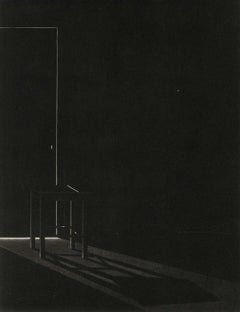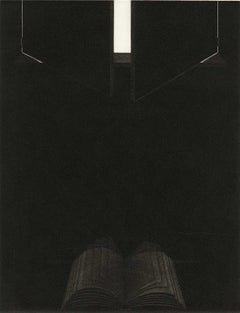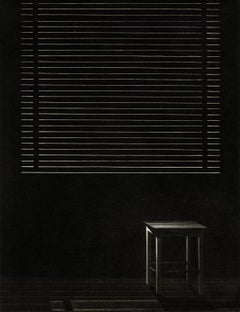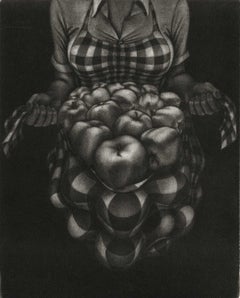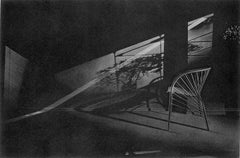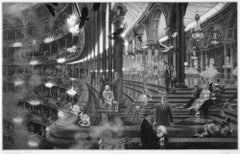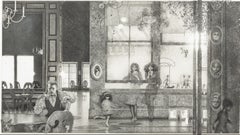Anne Dykmans Interior Prints
Belgian, b. 1952
Anne Dykmans is an established artist. Anne Dykmans was born in 1952. Artists born in the same year and of the same generation are Raúl Blisniuk, Peter Andersson, José Macaparana, Ricardo Cejudo Nogales, and Abolfazl Beytoei.
Further Biographical Context for Anne Dykmans
Born in 1952, Anne Dykmans was primarily influenced by the 1970s. The 1970s were a period of consolidation and development in the arts, most often characterised as a response to the central strains of the previous decade. Conceptual art developed as a key movement, and was in part an evolution of and response to minimalism. Land Art took the works of art into the extensive outdoors, taking creative production away from commodities and engaging with the earliest ideas of environmentalism. Process art combined elements of conceptualism with other formal reflections, creating esoteric and experimental bodies of work. Expressive figurative painting began to regain importance for the first time since the decline of Abstract Expressionism twenty years prior, especially in Germany where Gerhard Richter, Anselm Kiefer, Georg Baselitz became highly respected figures worldwide. A number of the artists who gained fame and successful in the 1960s remained dominant figures. For example, Andy Warhol branched out into film and magazine publishing, the first kind of cross cultural activity for a visual artist. This secured his reputation as a globally renowned celebrity in his own right. Towards the end of the decade, the emerging practices of graffiti and street art were beginning to gain attention in the fine art community. Artists like Keith Haring and Jean-Michel Basquiat were working in downtown Manhattan and guaranteeing that spray paint and tagging gained some acceptability as a fine art practice, a trend which would fully develop and dominate during the next decade.
(Biography provided by Stone and Press Gallery)
to
3
5
3
2
4
1
Overall Height
to
Overall Width
to
2
2
4
2
1
1
1
1
1
1
1
1
1
1
1
1
1
5
4
1
10
90
86
74
51
5
5
1
1
Artist: Anne Dykmans
Carbonrel
By Anne Dykmans
Located in New Orleans, LA
This impression was created in 1977 and is #20 out of edition of25
Anne Dykmans employs her superb command of engraving techniques, especially mezzotint, to create a special light w...
Category
1970s Contemporary Anne Dykmans Interior Prints
Materials
Mezzotint
Livre (An opening to the book of knowledge)
By Anne Dykmans
Located in New Orleans, LA
This image seems to capture the opening of knowledge through books. At the top of the imagemoors are opening revealing a sliver of light providing entree to yer massive book at the ...
Category
1970s Anne Dykmans Interior Prints
Materials
Mezzotint
Store I
By Anne Dykmans
Located in New Orleans, LA
In "Store I", Anne Dykmans depicts the stark outline of a very modest store interior.
Anne Dykmans employs her superb command of engraving techniques, especially mezzotint, to creat...
Category
1970s Modern Anne Dykmans Interior Prints
Materials
Mezzotint
Fructidore (Fruit being carried is hard to distinguish from the woman's body)
By Anne Dykmans
Located in New Orleans, LA
In Anne Dykmans' "Fructidore", a well endowed woman uses her plaid apron to carry a bunch of fruit. Parts of her body clothed in plaid seem to suggest the same fruit she is carrying...
Category
1970s Modern Anne Dykmans Interior Prints
Materials
Mezzotint
Rue du Printemps (Shadows in house on Spring Street in Brussels)
By Anne Dykmans
Located in New Orleans, LA
Light pours through a sparsely furnished room in a space on Spring Street in Brussels creating stark shadows as it streaks through the bushes, blinds and the outline of a modern chai...
Category
1990s Contemporary Anne Dykmans Interior Prints
Materials
Aquatint, Mezzotint
Related Items
Points of Departure II: Nijinsky Variations
By Peter Milton
Located in Middletown, NY
Points of Departure II: Nijinsky Variations
Robert E. Townsend, 1996
Resist-ground etching and engraving on BFK-Rives paper, 24 x 38 inches (618 x 965 mm), full margins. Signed, ti...
Category
1990s American Modern Anne Dykmans Interior Prints
Materials
Etching, Engraving
Interiors I: Family Reunion — A penetrating scene with a hidden homage to Eadwea
By Peter Milton
Located in Middletown, NY
Interiors I: Family Reunion
1984
Resist ground etching and engraving on BFK Rives wove paper, 20 x 36 inches (501 x 913 mm), full margins. Signed, titled, dated and numbered 49/175 in pencil, lower margin. In excellent condition with minor mat tone. A luminous, rich, and well-inked impression of this haunting image, with astonishing detail and depth. Framed handsomely under museum grade glass with archival materials in a solid wood frame with silver finish. [Milton 107]
Intended to be a stand alone image in its inception, Family Reunion ended up spawning seven additional images, and became a sort of Primo Pensiero in the sprawling, masterpiece suite now known as Interiors. The suite took eight years to complete, and consists of works of varying format, psychological intensity, and subject matter. The thematic darkness in the eight images waxes and wanes, and Milton intentionally included several interlude works to lighten the tension he felt while composing several of the darker images. The first two in the series, Family Reunion, and Hotel Paradise Café, were meant to be companion pieces. The equilibrium of each composition is anchored on a central brooding figure; a man (perhaps based on a Thomas Eakins portrait of the American anthropologist Frank Hamilton...
Category
1980s American Modern Anne Dykmans Interior Prints
Materials
Etching, Engraving
Interiors VII: The Train from Munich
By Peter Milton
Located in Middletown, NY
Interiors VII: The Train from Munich
Robert E. Townsend, 1991.
Resist ground etching and engraving with hand refinement in charcoal, pencil, stabilo, and eraser on BFK Rives white wove paper, 20 x 36 inches (507 x 914 mm), full margins. Signed, titled, dated and numbered 51/175 by the artist in pencil, lower margin. A brilliant, inky impression with luminous light and gradient tones. In excellent condition with one extremely minor and superficial spot of light tan adhesive residue on the verso, unobtrusive and not visible on the recto, with no other visible defects. With the blind stamp of the printer, Robert E. Townsend in the lower left margin. An especially fine impression in superb condition. [Milton 113].
When asked about this work in particular, Milton expressed that his favorite images were his darkest images, in theme, mood, and in ink. Milton, who has said that his work is infused with a postmodern awareness of the past, has focused here in a deeply personal way on a segment of history that continues to haunt us all. The work, published in 1991, evokes one of the darkest periods of European history, the eroding and erasing of European culture under fascism, and the eventual total loss of humanity. The Train from Munich is an especially relevant and emotional work for Milton, who created the piece for his wife, Edith, who escaped Munich in 1939 as a child on the fabled Kinderstransport. The Kinderstransport was a desperate rescue effort on the part of the British government to save as many Jewish children as possible by railway before borders closed on the precipice of the Second World War. Children left their parents behind, and boarded the trains alone, leaving the impending doom of Nazi Germany, they arrived in Great Britain as refugees. More than 10,000 children escaped the holocaust via the Kinderstransport. In Train from Munich, the image itself holds an almost immeasurable amount of symbolism; each inch of the matrix is a successful effort to confront this history in a way that is poignant through a series of motifs. We see the Café disappearing into a ghostlike memory of the past, an allegory to the disintegration of culture, while through the windows we can see a rampant, snarling dog; a portrait of Hitler's shepherd, Blondi. Blondi isn't the only notable figure in the composition. Milton has pointed out that the fading figure of the doorman at the Hotel Metropole is modeled after the artist and intellectual Marcel Duchamp, and the face of the young girl peering...
Category
1990s American Modern Anne Dykmans Interior Prints
Materials
ABS, Charcoal, Engraving, Etching
Intérieur à Pressy
By Erik Desmazières
Located in Palm Springs, CA
Signed and numbered from the edition of 90.
While grand architecture and imaginary places feature in the artist’s fantastical prints, his more intimate interior scenes like Intéri...
Category
1990s Contemporary Anne Dykmans Interior Prints
Materials
Etching, Aquatint
Table of Summer Fruits - Original Lithograph
Located in Paris, FR
Moise KISLING
Table of Summer Fruits
Original Lithograph
On Arches vellum
28 x 38 cm (c. 11 x 15 inches)
Very good condition
Category
1950s Modern Anne Dykmans Interior Prints
Materials
Lithograph
"King of the Friendly Islands" (Tonga); Engraving from Captain Cook's 3rd Voyage
By John Webber
Located in Alamo, CA
"Poulaho, King of the Friendly Islands, Drinking Kava" is an engraving created by William Sharp (1749-1824), from a drawing by John Webber (1752-1793), who was the artist on Captain James Cook's 3rd and final voyage of discovery. It was published in the atlas of "A Voyage to the Pacific Ocean Undertaken by the Command of His Majesty, for Making Discoveries in the Northern Hemisphere", the official British Admirality sanctioned journal published upon completion of the voyage in London in 1784 by Strahan & Cadell.
Captain Cook visited Tonga on his 3rd voyage, which he named The Friendly Islands because of the warm welcome he and his crew received, unlike some of the other more hostile Pacific islands. The engraving depicts Cook and his men observed a kava ceremony at the village of Mu’a on Tongatapu. King Paulaho sits in the centre foreground, his back to the spectator with a man kneeling before him. The ceremonial mat depicted behind Paulaho indicates that nobody was allowed to sit behind him. The figure in the centre holds a single cup, referring to the Tongan custom of offering the cup to the king first. Kava is native to the islands of the South Pacific and was first described for English readers in 1768 by Captain James Cook. The kava root has been used for centuries as a central feature of ceremonies and celebrations because it was able to bring about a calming and pleasant social atmosphere. The root was crushed and processed into coconut milk to become the focal ceremonial beverage, simply referred to as kava.
This engraving is presented in a Koa wood frame and a white mat. Koa wood is legendary in Hawaii. There are occasional faint spots, but the print is otherwise in very good condition. This amazing Koa wood is native to Hawaii and it is known for the deep rich colors and varied grain pattern. Koa has an honored heritage in Hawaii and is highly revered and sacred. The word “koa” means “warrior” in Hawaiian. The warriors of King Kamehameha the Great, created canoes and weapons from a wood plentiful on the Big Island of Hawaii. This wood became synonymous with the warriors themselves, and it became known as koa.
There are three other engravings listed from the official journal of Captain Cook's 3rd voyage available that are presented in identical Koa wood frames and mats (LU117324682422, LU117324684052, LU117324684032). They would make a wonderful grouping for a display of 2, 3 or 4 prints. A discount is available for a grouping depending on the number of items included.
Captain Cook is remembered as one of the greatest explorers and navigators in history. His explorations included Australia, New Zealand and islands of the South Pacific and the northwest coast of North America. Hawaii was discovered by Captain Cook during this voyage. Hawaii was originally called The Sandwich Islands in honor of The Earl of Sandwich...
Category
1780s Realist Anne Dykmans Interior Prints
Materials
Engraving
H 18.25 in W 23.5 in D 0.88 in
Vintage Fauvist Color Lithograph Porch Scene Jamaican Artist Van Pitterson
By Lloyd Van Pitterson
Located in Surfside, FL
Afternoon Delight
Wicker front porch chair and furniture.
Framed 19 X 23 image is 13 x 17.
Lloyd van Pitterson was born in Jamaica, West Indies. H...
Category
20th Century Post-Impressionist Anne Dykmans Interior Prints
Materials
Lithograph
Women at Prayer
By Robert Sargent Austin, R.A., P.R.E., P.R.W.S.
Located in Storrs, CT
10 15/16 x 8 7/16 (sheet 13 13/16 x 10 13/16). Subsequent to Dodgson. Edition 40 published by the Twenty-One Gallery for 7 guineas. Illustrated: Fine Prints of the Year, 1936. A rich...
Category
1930s Renaissance Anne Dykmans Interior Prints
Materials
Engraving
Flowers and Fruit in Front of the Window Still Life- School of Paris
By Yves Ganne
Located in Soquel, CA
Brightly colored lithograph still-life by Yves Ganne (French, b. 1931). Signed "Y. Ganne" in the lower right corner. Numbered "19/260" in the lower left corner. Presented in a tan ma...
Category
Late 20th Century Post-Impressionist Anne Dykmans Interior Prints
Materials
Paper, Ink, Screen
H 27.5 in W 21.25 in D 0.75 in
CHINESE RHODODENDRONS Hand Drawn Lithograph, Watercolor Floral, Pastel Colors
By Glenny Brazy
Located in Union City, NJ
CHINESE RHODODENDRONS is an original hand drawn lithograph printed using hand lithography techniques on archival Arches paper 100% acid free. Lovely watercolor floral...
Category
1980s Contemporary Anne Dykmans Interior Prints
Materials
Lithograph
Vase de Fleurs, Cubist Lithograph by Pablo Picasso
By Pablo Picasso
Located in Long Island City, NY
A lithograph from the Marina Picasso Estate Collection after the Pablo Picasso painting "Vase de Fleurs". The original painting was completed in 1958. In the 1970's after Picasso's ...
Category
1980s Modern Anne Dykmans Interior Prints
Materials
Lithograph
American Modernist "Feast of Pure Reason" Aquatint Mezzotint Etching WPA Artist
By Jack Levine
Located in Surfside, FL
Jack Levine, American, 1915–2010
The Feast of Pure Reason, 1970
Etching, mezzotint and aquatint on copper in black ink.
20 w. 25 in., sight
overall: 27 x 31.75 in., matted.
Depict...
Category
1970s Expressionist Anne Dykmans Interior Prints
Materials
Mezzotint, Etching, Aquatint
Anne Dykmans interior prints for sale on 1stDibs.
Find a wide variety of authentic Anne Dykmans interior prints available for sale on 1stDibs. You can also browse by medium to find art by Anne Dykmans in engraving, mezzotint, aquatint and more. Much of the original work by this artist or collective was created during the 20th century and is mostly associated with the modern style. Not every interior allows for large Anne Dykmans interior prints, so small editions measuring 5 inches across are available. Customers who are interested in this artist might also find the work of Jukka Vanttinen, Yuji Hiratsuka, and Piero Cesaroni. Anne Dykmans interior prints prices can differ depending upon medium, time period and other attributes. On 1stDibs, the price for these items starts at $125 and tops out at $600, while the average work can sell for $315.
